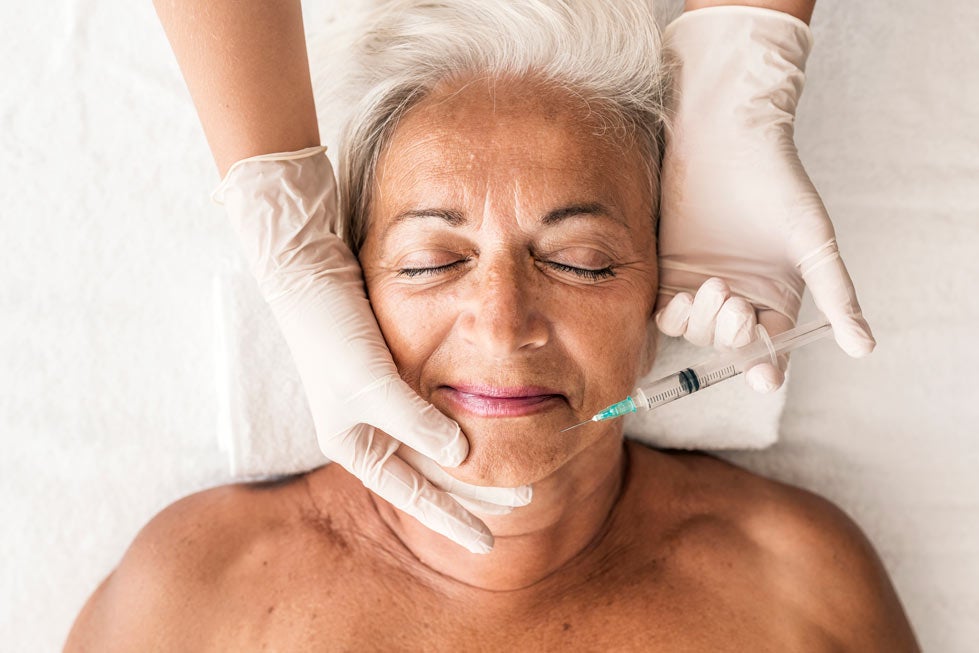What is photoaging?
Too much sun exposure can cause premature aging of your skin. This premature wrinkling and skin damage from sun exposure is called photoaging. Photoaging is not like natural aging. It causes:
-
Coarse, dry skin.
-
Freckling and skin discoloration.
-
Leathery skin.
-
Deep wrinkles.
Prevention is the best treatment for photoaging. Wearing sunscreen and avoiding excessive sun exposure are key. A daily facial moisturizer with an SPF of at least 15 may help eliminate the need for the sometimes-expensive procedures listed below.
Treatment for sun-damaged skin
No one can stop the natural process of aging, as the skin thins and lines and wrinkles appear. Moles, scars, and birthmarks also tend to change as we age. In addition, sun damage over the course of a lifetime worsens the aging skin. Sometimes treating advanced signs of aging and sun damage may require more invasive dermatology procedures, such as:
-
Botulinum toxin type A. Injecting botulinum toxin into certain muscles blocks signals from the nerves to the muscles. The muscles that are injected no longer contract. This prevents the muscles from forming wrinkles and furrows. Using botulinum will soften existing wrinkles. But it won’t prevent the signs of aging. It is most often used for forehead lines and the lines between and around the eyes.
-
Chemical peels. Chemical peels are often used to minimize sun-damaged skin, irregular skin color (pigment), and superficial scars. The top layer of skin is removed or irritated with a chemical applied to the skin. Inflammation results, and new skin regenerates. This often improves its appearance.
-
Soft tissue augmentation or dermal filler injections. A soft tissue filler is injected beneath the skin to replace the body's natural hyaluronic acid and collagen that have been lost. There are many different kinds of fillers available. Fillers are generally used to treat wrinkles, scars, and facial lines. They also treat wrinkles caused by volume loss and repetitive muscle contraction. Fillers are also used to plump up lips and enhance shallow contours and cheekbones.
-
Dermabrasion. This is sometimes called dermaplaning. It may be used to minimize small scars, minor skin surface irregularities, surgical scars, and acne scars. This treatment removes the top layers of skin with a manual or electrical machine that scrapes (abrades) the skin. As the skin heals from the procedure, the surface looks smoother and fresher. It can be used for the whole face or for certain areas or scars. Dermabrasion is sometimes used for aging. But it has generally been replaced by other methods. Microdermabrasion is a gentler type of dermabrasion. A special machine applies tiny rough particles to remove the uppermost layer of dead skin to stimulate new skin growth. This procedure works best on mild to moderate skin damage. It may require several treatments.
-
Laser skin resurfacing. Laser skin resurfacing uses high-energy light to remove the upper layers of damaged skin. Laser resurfacing may be used to minimize wrinkles and fine scars. It is also used to reduce enlarged oil glands, lighten up sunspots, and remove wart-like growths. A newer treatment option is called nonablative resurfacing. This type of resurfacing also uses a laser, light, and other energy-based treatments, but it does not damage the top layers of skin.
-
Intense pulsed light (IPL) therapy. IPL therapy uses an intense but gentle beam of light to treat aging skin. IPL is a type of nonablative therapy. This means it does not damage the top layers of skin.
-
Tretinoin treatment. This prescription skin cream, which is a form of vitamin A, can reduce wrinkles, rough skin, fine lines, and discolored skin.


